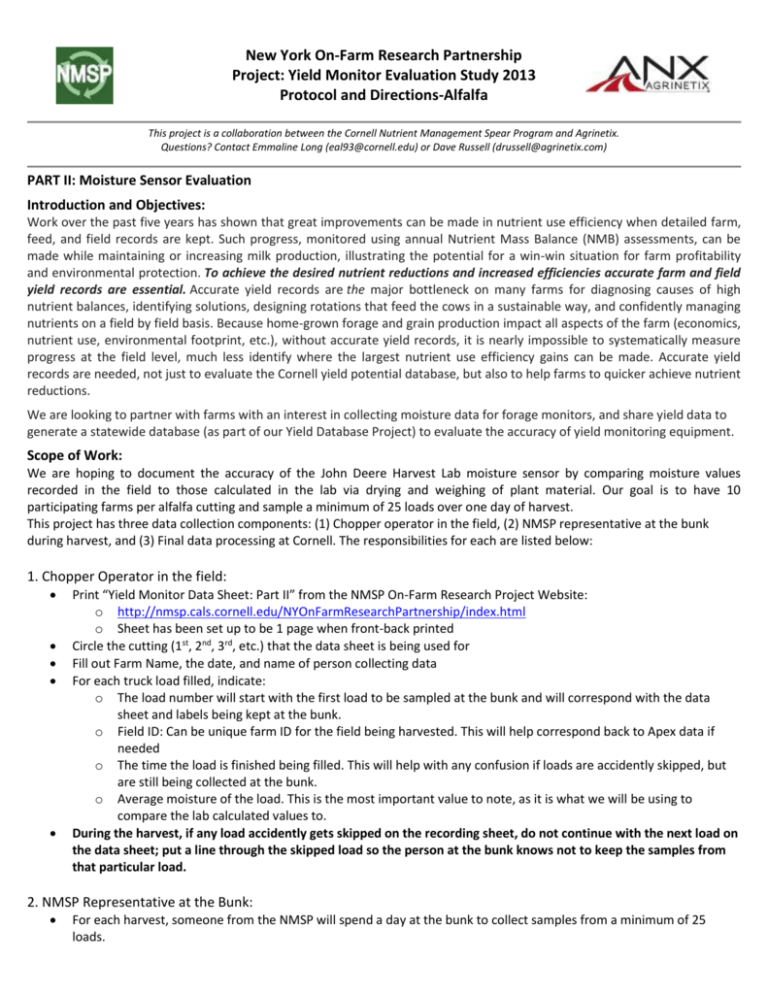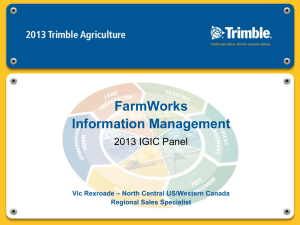Protocol Moisture Calibration for Forage Monitors for Alfalfa
advertisement

New York On-Farm Research Partnership Project: Yield Monitor Evaluation Study 2013 Protocol and Directions-Alfalfa This project is a collaboration between the Cornell Nutrient Management Spear Program and Agrinetix. Questions? Contact Emmaline Long (eal93@cornell.edu) or Dave Russell (drussell@agrinetix.com) PART II: Moisture Sensor Evaluation Introduction and Objectives: Work over the past five years has shown that great improvements can be made in nutrient use efficiency when detailed farm, feed, and field records are kept. Such progress, monitored using annual Nutrient Mass Balance (NMB) assessments, can be made while maintaining or increasing milk production, illustrating the potential for a win-win situation for farm profitability and environmental protection. To achieve the desired nutrient reductions and increased efficiencies accurate farm and field yield records are essential. Accurate yield records are the major bottleneck on many farms for diagnosing causes of high nutrient balances, identifying solutions, designing rotations that feed the cows in a sustainable way, and confidently managing nutrients on a field by field basis. Because home-grown forage and grain production impact all aspects of the farm (economics, nutrient use, environmental footprint, etc.), without accurate yield records, it is nearly impossible to systematically measure progress at the field level, much less identify where the largest nutrient use efficiency gains can be made. Accurate yield records are needed, not just to evaluate the Cornell yield potential database, but also to help farms to quicker achieve nutrient reductions. We are looking to partner with farms with an interest in collecting moisture data for forage monitors, and share yield data to generate a statewide database (as part of our Yield Database Project) to evaluate the accuracy of yield monitoring equipment. Scope of Work: We are hoping to document the accuracy of the John Deere Harvest Lab moisture sensor by comparing moisture values recorded in the field to those calculated in the lab via drying and weighing of plant material. Our goal is to have 10 participating farms per alfalfa cutting and sample a minimum of 25 loads over one day of harvest. This project has three data collection components: (1) Chopper operator in the field, (2) NMSP representative at the bunk during harvest, and (3) Final data processing at Cornell. The responsibilities for each are listed below: 1. Chopper Operator in the field: Print “Yield Monitor Data Sheet: Part II” from the NMSP On-Farm Research Project Website: o http://nmsp.cals.cornell.edu/NYOnFarmResearchPartnership/index.html o Sheet has been set up to be 1 page when front-back printed Circle the cutting (1st, 2nd, 3rd, etc.) that the data sheet is being used for Fill out Farm Name, the date, and name of person collecting data For each truck load filled, indicate: o The load number will start with the first load to be sampled at the bunk and will correspond with the data sheet and labels being kept at the bunk. o Field ID: Can be unique farm ID for the field being harvested. This will help correspond back to Apex data if needed o The time the load is finished being filled. This will help with any confusion if loads are accidently skipped, but are still being collected at the bunk. o Average moisture of the load. This is the most important value to note, as it is what we will be using to compare the lab calculated values to. During the harvest, if any load accidently gets skipped on the recording sheet, do not continue with the next load on the data sheet; put a line through the skipped load so the person at the bunk knows not to keep the samples from that particular load. 2. NMSP Representative at the Bunk: For each harvest, someone from the NMSP will spend a day at the bunk to collect samples from a minimum of 25 loads. The graduate student in charge of the project, Emmaline, will most likely be the person. If more than one farm is harvesting on a given day, a research technician or summer intern will be the person at the bunk. One- 1 gallon bag will be sampled from each load dumped. o Sampling protocol: Take one large handful at a time walking around the dumped pile, for a total of 6 large handfuls. o If more than one person is available that day, five- 1 gallon samples will be taken per load to estimate with-in load variability of moisture. Bags will be labeled with load number (and sample number if relevant) and placed in a cooler. 3. Final processing at Cornell University Upon returning from the farm, plant material from each gallon bag will be weighed and recorded. Samples will be placed in an oven for approximately 3 days, and reweighed to get dry weight and moisture content at harvest. If questions, contact: Emmaline Long, eal93@cornell.edu, 585-813-7228 (cell) 323 Morrison Hall, Ithaca, NY 14853 Yield Monitor Study 2013 Data Sheet for Alfalfa Harvest Circle Cutting: First Second Third Fourth Fifth This project is a collaboration between the Cornell Nutrient Management Spear Program and Agrinetix. Questions? Contact Emmaline Long (eal93@cornell.edu) or Dave Russell (drussell@agrinetix.com) Farm Name: _______________________________________ Date: _____________________________________ Person collecting data:__________________________ Load Moisture Information: Load Number Field ID Time of Load 1 _____:______ 2 _____:______ 3 _____:______ 4 _____:______ 5 _____:______ 6 _____:______ 7 _____:______ 8 _____:______ 9 _____:______ 10 _____:______ 11 _____:______ 12 _____:______ 13 _____:______ 14 _____:______ 15 _____:______ 16 _____:______ 17 _____:______ Avg. Moisture of Load % Load Number Field ID Time of Load 18 _____:______ 19 _____:______ 20 _____:______ 21 _____:______ 22 _____:______ 23 _____:______ 24 _____:______ 25 _____:______ 26 _____:______ 27 _____:______ 28 _____:______ 29 _____:______ 30 _____:______ 31 _____:______ 32 _____:______ 33 _____:______ 34 _____:______ 35 _____:______ 36 _____:______ 37 _____:______ 38 _____:______ 39 _____:______ 40 _____:______ Avg. Moisture of Load %





